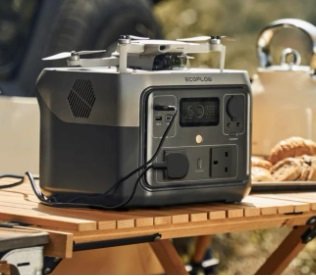RV travel offers freedom, but keeping your appliances running can be tricky. Traditional RVs rely on noisy gas generators or campground hookups, which limit where you can stay. The portable power station has emerged as a quieter, cleaner alternative, but are they truly practical for RV life? These compact battery units can power everything from your fridge to your laptop, yet many travelers wonder if they’re powerful enough for extended trips. Unlike bulky generators, portable power stations produce no fumes, making them ideal for national parks and boondocking. But choosing the right one requires understanding your energy needs and the station’s capabilities.
1. Key Benefits for RVers
Quiet Operation vs. Noisy Generators
One of the biggest advantages of portable power stations is their near-silent operation. Traditional gas generators can be loud, disturbing both your peace and nearby campers. Many parks even restrict their use during quiet hours. A power station, on the other hand, runs without noise, letting you enjoy nature or sleep undisturbed. This makes them perfect for overnight stops in rest areas or dispersed camping sites where noise regulations apply. You can charge phones, run a small fan, or even power a CPAP machine without annoying your neighbors. Additionally, since there’s no engine vibration, you won’t have to worry about the constant hum affecting your relaxation. For those who value tranquility, this is a game-changer.
Zero Emissions for Eco-Friendly Camping
Gas generators emit fumes, which can be unpleasant and harmful to the environment. Portable power stations, especially solar-compatible ones, provide a greener alternative. They store energy in lithium batteries and release no exhaust, making them safe to use in enclosed spaces like an RV. This eco-friendly feature is particularly useful in national parks and forests, where air quality and noise restrictions are strict. Solar charging further reduces your carbon footprint, allowing you to recharge using sunlight instead of gasoline. If sustainability matters to you, a power station aligns much better with an outdoor lifestyle.
Lightweight and Portable Compared to Built-In Systems
Unlike permanent RV battery banks, portable power stations are easy to move. You can take them out for picnics, use them in a tent, or even bring them home during power outages. Many models weigh under 30 pounds, making them manageable for most people. This flexibility is great for travelers who switch between different vehicles or camping styles. If you own both an RV and a car, you can use the same power station for both trips. Some models even come with carrying handles or wheels, so transporting them is effortless. For those who dislike complicated installations, plug-and-play convenience is a major plus.

2. Power Capacity Considerations
Calculating Your RV’s Energy Needs (Fridge, Lights, etc.)
Before buying a power station, you need to estimate how much energy your RV appliances consume. Start by listing essential devices—such as your fridge, lights, phone charger, and perhaps a small fan or coffee maker. Check their wattage (usually labeled) and calculate daily usage. For example, a 12V RV fridge might use about 60 watts per hour, running 8 hours a day (480Wh). LED lights may add another 50Wh, and charging devices another 100Wh. Add a safety buffer (20-30%) to account for inefficiencies. This total will help you choose a power station with sufficient capacity.
Matching Station Capacity to Trip Duration
A small power station (300-500Wh) might suffice for weekend trips if you only need to charge phones and run lights. However, longer trips or high-power appliances (like a microwave or electric kettle) require 1000Wh or more. Solar compatibility extends your runtime, especially if you camp off-grid for days. Some stations recharge fully in 2-3 hours via solar panels, while others may take longer. Always check recharge times and whether the station supports simultaneous charging and discharging (pass-through charging).
3. Solar Compatibility for Extended Trips
Solar panels turn sunlight into free, renewable energy—ideal for long-term RV travel. Many power stations support solar input, though charging speed depends on panel wattage and sunlight conditions. A 100W solar panel might take 8-10 hours to fully recharge a 500Wh station, while a 200W panel cuts that time in half. Look for MPPT (Maximum Power Point Tracking) technology, which optimizes solar charging efficiency. Also, ensure the station’s input voltage matches your solar panel’s output. For off-grid adventurers, solar compatibility means near-limitless power if planned correctly.
4. Important Features for RV Use
30A RV Outlet Availability
Most RVs use a 30A plug for shore power. Some power stations include this outlet, letting you connect directly without an adapter. If your station lacks one, you’ll need a 30A to 15A adapter, but this may limit high-power appliances.
Pass-Through Charging Capability
Pass-through charging allows you to recharge the station while simultaneously powering devices. This is useful at campgrounds where you can plug into shore power and still run your RV’s systems. Not all stations support this, so check before buying.
Temperature Tolerance for All Seasons
Lithium batteries perform poorly in extreme cold or heat. If you camp in freezing temperatures, look for a station with low-temperature protection. Some models even include self-heating functions to maintain efficiency in winter.
5. Limitations to Consider
Portable power stations aren’t perfect. They can’t match the raw output of gas generators for high-wattage appliances like air conditioners. Large-capacity models are also expensive, and solar charging depends on weather conditions. Always weigh these factors against your needs.
Conclusion
Portable power stations are excellent for quiet, emission-free, and flexible RV power. They work best for light to moderate energy needs, especially when paired with solar panels. If you prioritize convenience and eco-friendliness over high-wattage output, they’re a fantastic choice. For reliable performance, the EcoFlow power station is a great option, offering fast charging, solar compatibility, and durable construction. Whether you’re a weekend camper or a full-time RVer, the right power station can make your travels smoother and more sustainable.
Refresh Date: August 30, 2025







